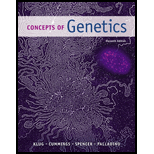
Concept explainers
(a)
To determine:
The effect of the single base mutation on the
Introduction:
The mutation is the changes or alteration in the genetic composition of the living organism. The mutations are caused by two different factors namely genetic factor and environmental factors. There are certain cancers like retinoblastoma can be passed from one generation to another generation. Environmental factors that induce cancer includes ionizing and non-ionising radiation, chemical carcinogens and lifestyle process.
(a)
Explanation of Solution
The mutation in genetic material can be induced or spontaneous. The spontaneous mutation occurs during the replication process in which the base pair is mistakenly placed in DNA. The induced mutation occurs by the environmental factors. The mutation is classified into different types namely single base transition, single base transversion, deletion, duplication, inversion, translocation, missense mutation, nonsense mutation, and frameshift mutation.
The change in base pair of A to T is the single base mutation or point mutation which is particularly called as transversion since the purine adenine is replaced by the pyrimidine thymine. The effect of this point mutation on the phenotypic traits is based on the location of basepair in coding ad non-coding regions, the number of factors involved, its interaction with other base sequences and its ability in dominance or recessiveness.
If the base changes occur in non-coding regions it does not affects the phenotypic trait. However, in some cases, the non-coding region influences the other sequences and this base changes may affect the phenotype. If the base mutation occurs in the coding regions, its effects are depended on the dominance and recessiveness. If the base changes act as the recessiveness there is no influence on the phenotype. If it acts as dominance then it affects the phenotype.
Thus the effects of point mutation from A to T on the phenotype depend on several factors.
Want to see more full solutions like this?
Chapter 15 Solutions
Concepts of Genetics (11th Edition)
 Human Anatomy & Physiology (11th Edition)BiologyISBN:9780134580999Author:Elaine N. Marieb, Katja N. HoehnPublisher:PEARSON
Human Anatomy & Physiology (11th Edition)BiologyISBN:9780134580999Author:Elaine N. Marieb, Katja N. HoehnPublisher:PEARSON Biology 2eBiologyISBN:9781947172517Author:Matthew Douglas, Jung Choi, Mary Ann ClarkPublisher:OpenStax
Biology 2eBiologyISBN:9781947172517Author:Matthew Douglas, Jung Choi, Mary Ann ClarkPublisher:OpenStax Anatomy & PhysiologyBiologyISBN:9781259398629Author:McKinley, Michael P., O'loughlin, Valerie Dean, Bidle, Theresa StouterPublisher:Mcgraw Hill Education,
Anatomy & PhysiologyBiologyISBN:9781259398629Author:McKinley, Michael P., O'loughlin, Valerie Dean, Bidle, Theresa StouterPublisher:Mcgraw Hill Education, Molecular Biology of the Cell (Sixth Edition)BiologyISBN:9780815344322Author:Bruce Alberts, Alexander D. Johnson, Julian Lewis, David Morgan, Martin Raff, Keith Roberts, Peter WalterPublisher:W. W. Norton & Company
Molecular Biology of the Cell (Sixth Edition)BiologyISBN:9780815344322Author:Bruce Alberts, Alexander D. Johnson, Julian Lewis, David Morgan, Martin Raff, Keith Roberts, Peter WalterPublisher:W. W. Norton & Company Laboratory Manual For Human Anatomy & PhysiologyBiologyISBN:9781260159363Author:Martin, Terry R., Prentice-craver, CynthiaPublisher:McGraw-Hill Publishing Co.
Laboratory Manual For Human Anatomy & PhysiologyBiologyISBN:9781260159363Author:Martin, Terry R., Prentice-craver, CynthiaPublisher:McGraw-Hill Publishing Co. Inquiry Into Life (16th Edition)BiologyISBN:9781260231700Author:Sylvia S. Mader, Michael WindelspechtPublisher:McGraw Hill Education
Inquiry Into Life (16th Edition)BiologyISBN:9781260231700Author:Sylvia S. Mader, Michael WindelspechtPublisher:McGraw Hill Education





